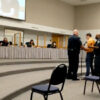
Photo of a vacant 7-11 in San Diego closed due to the blackout. Photo taken by Flickr user @nathangibbs
Earthquakes, hurricanes, floods, and now blackouts? One might say Mother Nature is on a rampage.
On Thursday around 3:45 p.m., 1.5 million people lost power. A mass blackout occurred spanning California, Arizona, and parts of Mexico. Affecting major cities throughout the region, the high-voltage power line outage between Arizona and California left millions without power. Sweltering heat and massive traffic pileups activated emergency operations in areas like San Diego. Blackouts continued throughout the evening, leaving small hope that any relief would come prior to late Friday.
Blackouts can come from electric disruptions, damaged voltage lines, natural disasters, explosions, and/or technical shutdowns. They can last for minutes, hours, or days. Until proper electricity and energy sources are fixed, the affected areas will remain without power.
Blackouts are dangerous because of their immediate effects. All major cities depend on electricity for daily functions. Computers, nuclear reactors, stoplights, hospitals, air conditioning, air traffic control, airport security screening equipment—all become useless. Security must be available in order to minimize riots, crowds, and looting.
Many remember the 2003 East Coast blackout, which left 50 million in Canada and the U.S. without power. During the past two decades, such blackouts have been on the rise. In less than 20 years, the incidence of blackouts in the United States increased 124 percent—up from 41 blackouts between 1991 and 1995 to 92 between 2001 and 2005, according to a study by the University of Minnesota.
The Federal Emergency Management Agency (FEMA) has guidelines titled “Rolling Blackouts into Disaster Planning.” FEMA is right to promote preparedness, but it is local governments and authorities, rather than the federal government, who ought to take the lead in preparation for blackouts. Instead of continuing its pace of responding to all manner of disasters, FEMA should focus on responding to those that are truly catastrophic in nature, coming to the aid of state and local responders when their resources and capabilities are overwhelmed.
























